Macroeconomics Report: US-China Trade War, Australia's Role, Impact
VerifiedAdded on 2021/02/22
|7
|1374
|66
Report
AI Summary
This macroeconomics report analyzes the US-China trade war, examining the objectives of the USA, China's responses, and the impact on Australia's economy. The report delves into the factors influencing the trade war, including tariffs on goods like pork and steel, and the subsequent effects on various industries. The analysis includes the actions taken by both countries, such as increased duties on exports, devaluation of currency, and the decrease in holdings of US treasury bonds. The report also explores the impact on Australia, highlighting how the trade war has influenced the country's unemployment rate, currency, and trade opportunities. The conclusion emphasizes that the trade war is unfavorable for both the US and China, and suggests the need for collaborative steps to resolve the conflict, including the effects on inflation and economic growth.
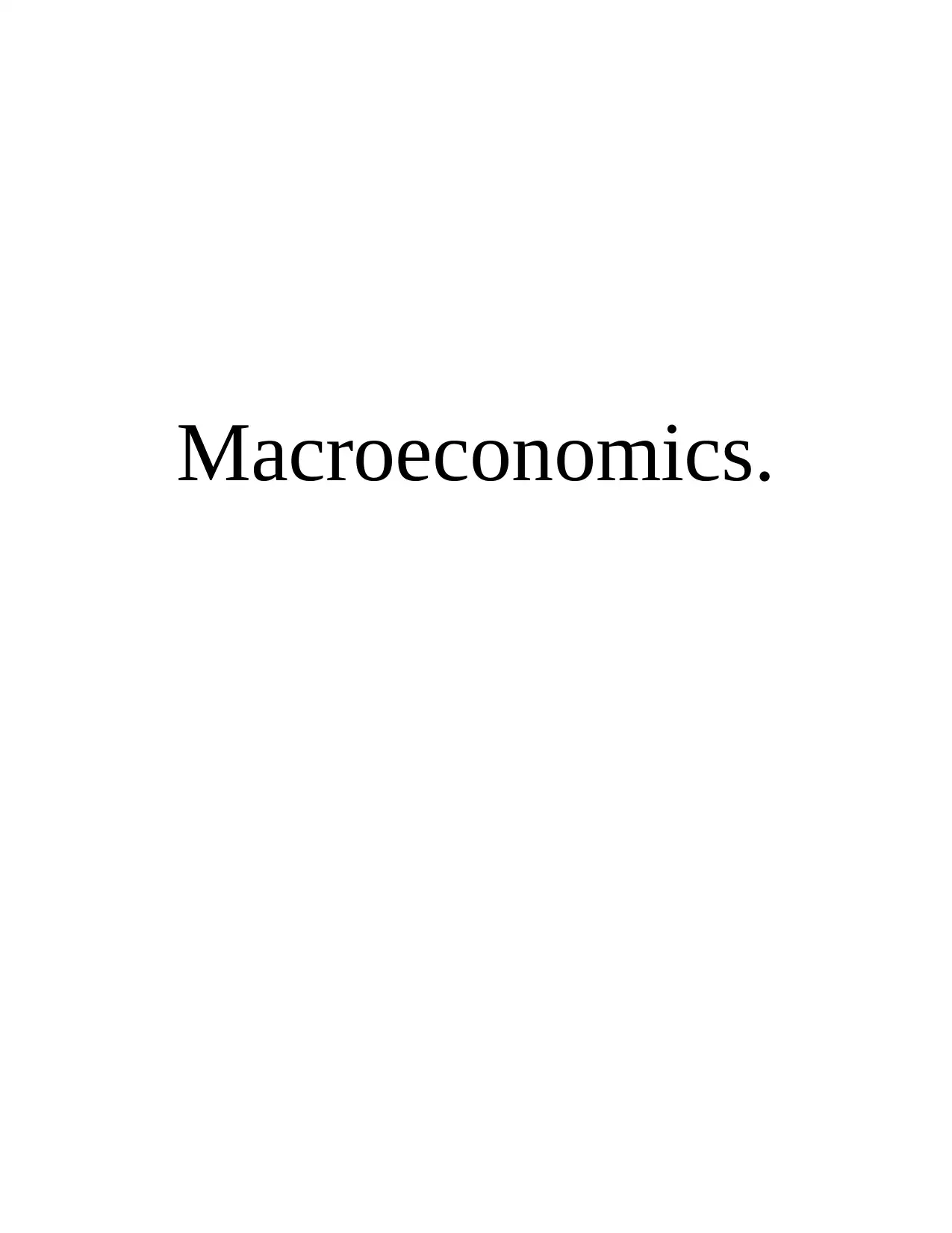
Macroeconomics.
Paraphrase This Document
Need a fresh take? Get an instant paraphrase of this document with our AI Paraphraser
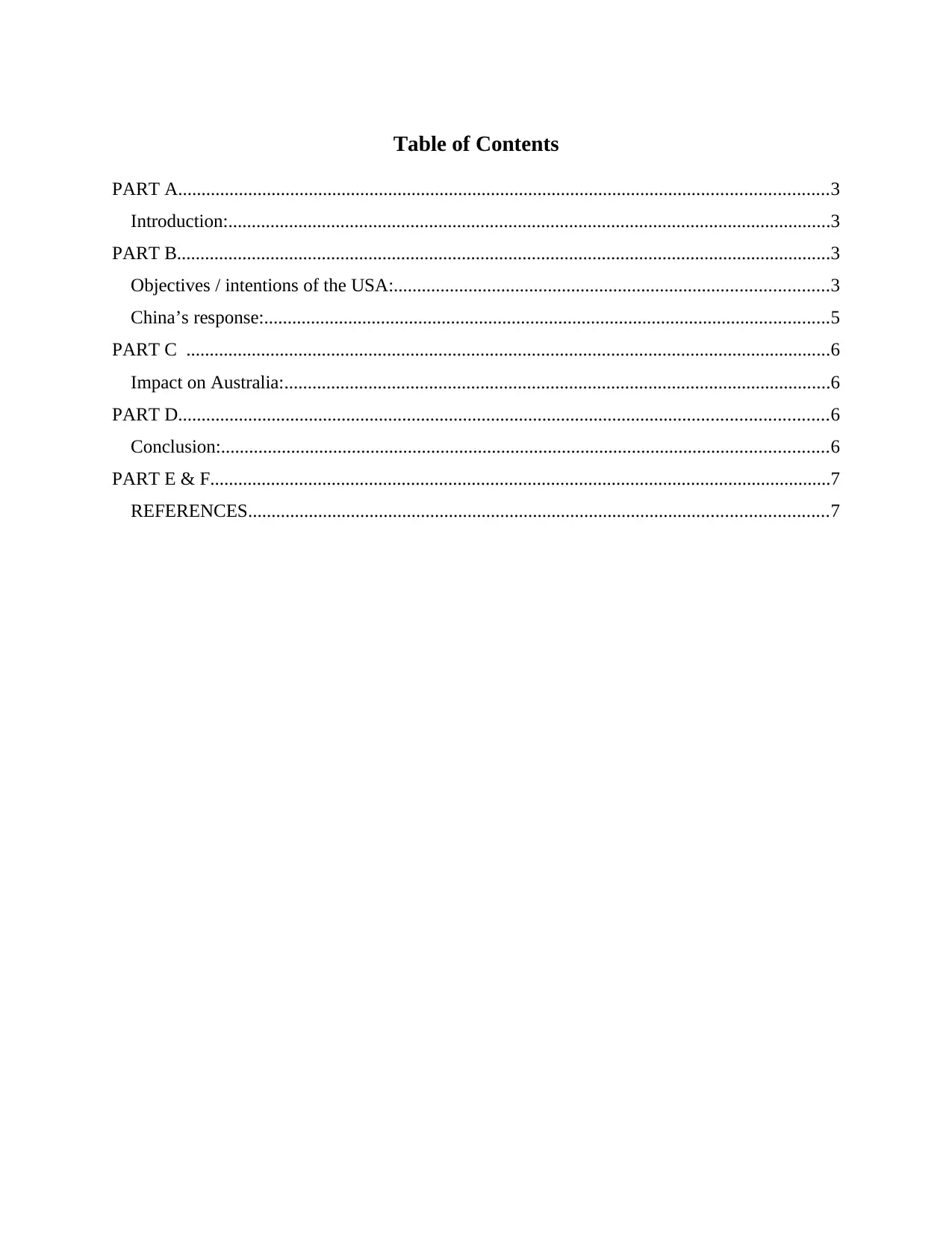
Table of Contents
PART A...........................................................................................................................................3
Introduction:.................................................................................................................................3
PART B............................................................................................................................................3
Objectives / intentions of the USA:.............................................................................................3
China’s response:.........................................................................................................................5
PART C ..........................................................................................................................................6
Impact on Australia:.....................................................................................................................6
PART D...........................................................................................................................................6
Conclusion:..................................................................................................................................6
PART E & F.....................................................................................................................................7
REFERENCES............................................................................................................................7
PART A...........................................................................................................................................3
Introduction:.................................................................................................................................3
PART B............................................................................................................................................3
Objectives / intentions of the USA:.............................................................................................3
China’s response:.........................................................................................................................5
PART C ..........................................................................................................................................6
Impact on Australia:.....................................................................................................................6
PART D...........................................................................................................................................6
Conclusion:..................................................................................................................................6
PART E & F.....................................................................................................................................7
REFERENCES............................................................................................................................7
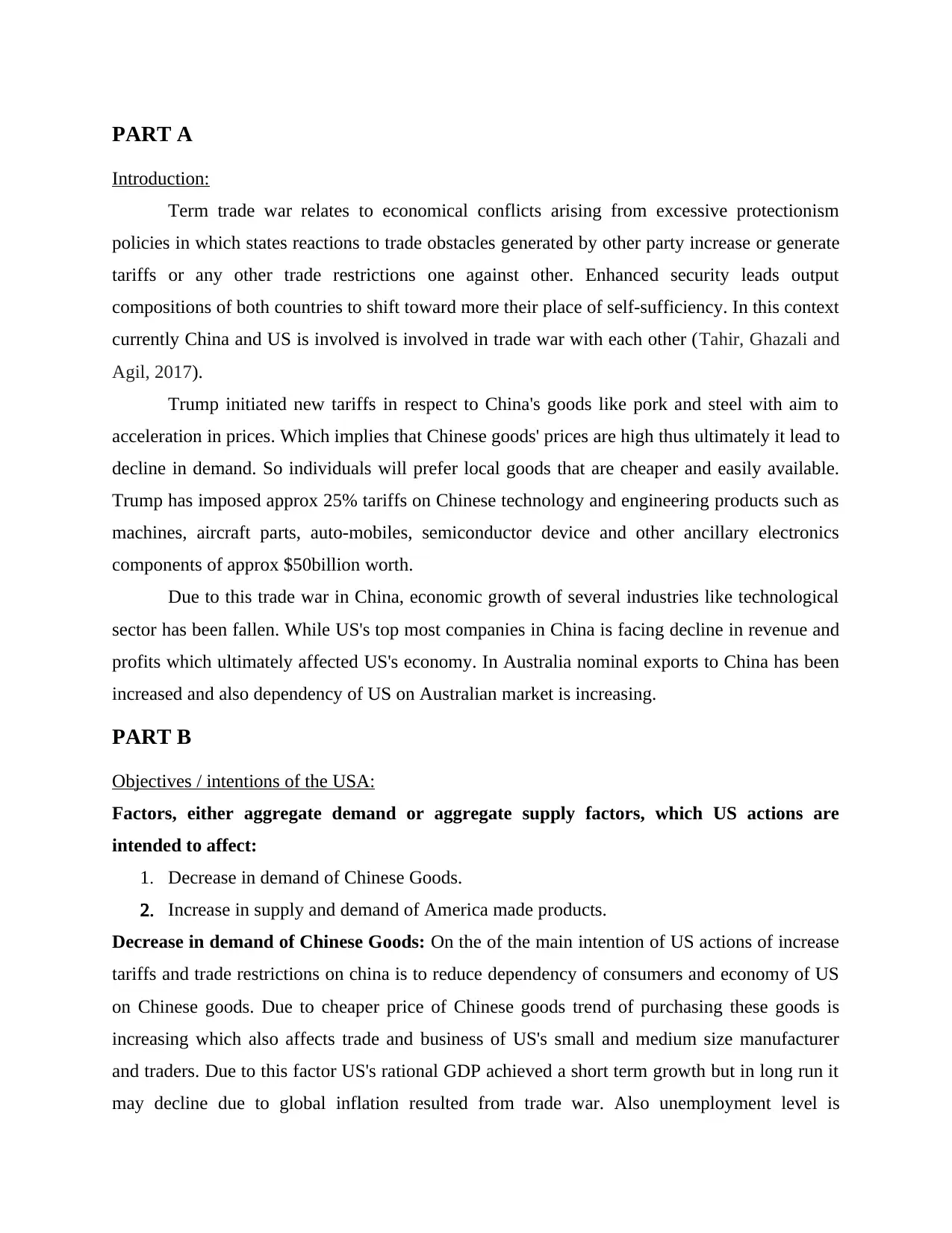
PART A
Introduction:
Term trade war relates to economical conflicts arising from excessive protectionism
policies in which states reactions to trade obstacles generated by other party increase or generate
tariffs or any other trade restrictions one against other. Enhanced security leads output
compositions of both countries to shift toward more their place of self-sufficiency. In this context
currently China and US is involved is involved in trade war with each other (Tahir, Ghazali and
Agil, 2017).
Trump initiated new tariffs in respect to China's goods like pork and steel with aim to
acceleration in prices. Which implies that Chinese goods' prices are high thus ultimately it lead to
decline in demand. So individuals will prefer local goods that are cheaper and easily available.
Trump has imposed approx 25% tariffs on Chinese technology and engineering products such as
machines, aircraft parts, auto-mobiles, semiconductor device and other ancillary electronics
components of approx $50billion worth.
Due to this trade war in China, economic growth of several industries like technological
sector has been fallen. While US's top most companies in China is facing decline in revenue and
profits which ultimately affected US's economy. In Australia nominal exports to China has been
increased and also dependency of US on Australian market is increasing.
PART B
Objectives / intentions of the USA:
Factors, either aggregate demand or aggregate supply factors, which US actions are
intended to affect:
1. Decrease in demand of Chinese Goods.
2. Increase in supply and demand of America made products.
Decrease in demand of Chinese Goods: On the of the main intention of US actions of increase
tariffs and trade restrictions on china is to reduce dependency of consumers and economy of US
on Chinese goods. Due to cheaper price of Chinese goods trend of purchasing these goods is
increasing which also affects trade and business of US's small and medium size manufacturer
and traders. Due to this factor US's rational GDP achieved a short term growth but in long run it
may decline due to global inflation resulted from trade war. Also unemployment level is
Introduction:
Term trade war relates to economical conflicts arising from excessive protectionism
policies in which states reactions to trade obstacles generated by other party increase or generate
tariffs or any other trade restrictions one against other. Enhanced security leads output
compositions of both countries to shift toward more their place of self-sufficiency. In this context
currently China and US is involved is involved in trade war with each other (Tahir, Ghazali and
Agil, 2017).
Trump initiated new tariffs in respect to China's goods like pork and steel with aim to
acceleration in prices. Which implies that Chinese goods' prices are high thus ultimately it lead to
decline in demand. So individuals will prefer local goods that are cheaper and easily available.
Trump has imposed approx 25% tariffs on Chinese technology and engineering products such as
machines, aircraft parts, auto-mobiles, semiconductor device and other ancillary electronics
components of approx $50billion worth.
Due to this trade war in China, economic growth of several industries like technological
sector has been fallen. While US's top most companies in China is facing decline in revenue and
profits which ultimately affected US's economy. In Australia nominal exports to China has been
increased and also dependency of US on Australian market is increasing.
PART B
Objectives / intentions of the USA:
Factors, either aggregate demand or aggregate supply factors, which US actions are
intended to affect:
1. Decrease in demand of Chinese Goods.
2. Increase in supply and demand of America made products.
Decrease in demand of Chinese Goods: On the of the main intention of US actions of increase
tariffs and trade restrictions on china is to reduce dependency of consumers and economy of US
on Chinese goods. Due to cheaper price of Chinese goods trend of purchasing these goods is
increasing which also affects trade and business of US's small and medium size manufacturer
and traders. Due to this factor US's rational GDP achieved a short term growth but in long run it
may decline due to global inflation resulted from trade war. Also unemployment level is
⊘ This is a preview!⊘
Do you want full access?
Subscribe today to unlock all pages.

Trusted by 1+ million students worldwide
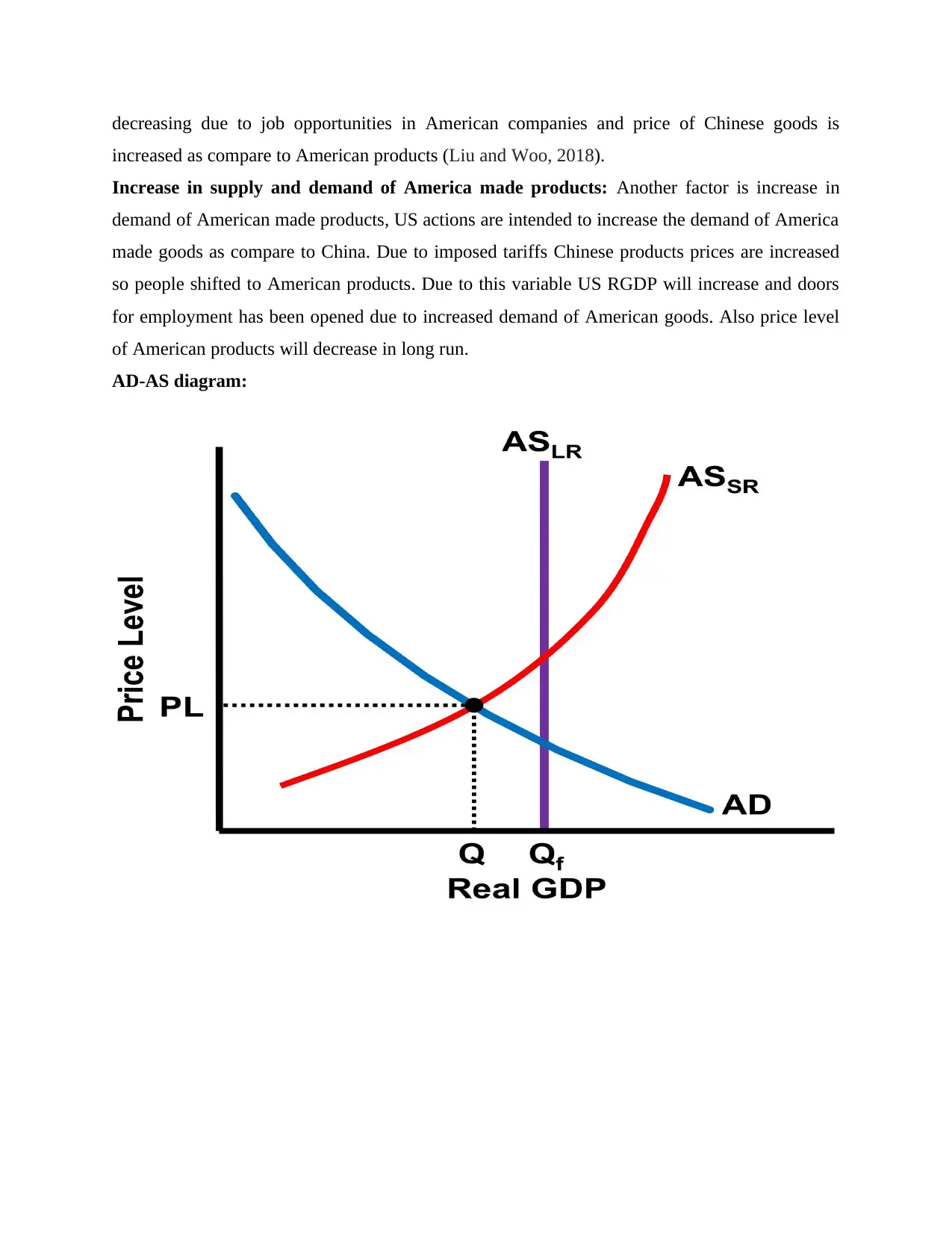
decreasing due to job opportunities in American companies and price of Chinese goods is
increased as compare to American products (Liu and Woo, 2018).
Increase in supply and demand of America made products: Another factor is increase in
demand of American made products, US actions are intended to increase the demand of America
made goods as compare to China. Due to imposed tariffs Chinese products prices are increased
so people shifted to American products. Due to this variable US RGDP will increase and doors
for employment has been opened due to increased demand of American goods. Also price level
of American products will decrease in long run.
AD-AS diagram:
increased as compare to American products (Liu and Woo, 2018).
Increase in supply and demand of America made products: Another factor is increase in
demand of American made products, US actions are intended to increase the demand of America
made goods as compare to China. Due to imposed tariffs Chinese products prices are increased
so people shifted to American products. Due to this variable US RGDP will increase and doors
for employment has been opened due to increased demand of American goods. Also price level
of American products will decrease in long run.
AD-AS diagram:
Paraphrase This Document
Need a fresh take? Get an instant paraphrase of this document with our AI Paraphraser
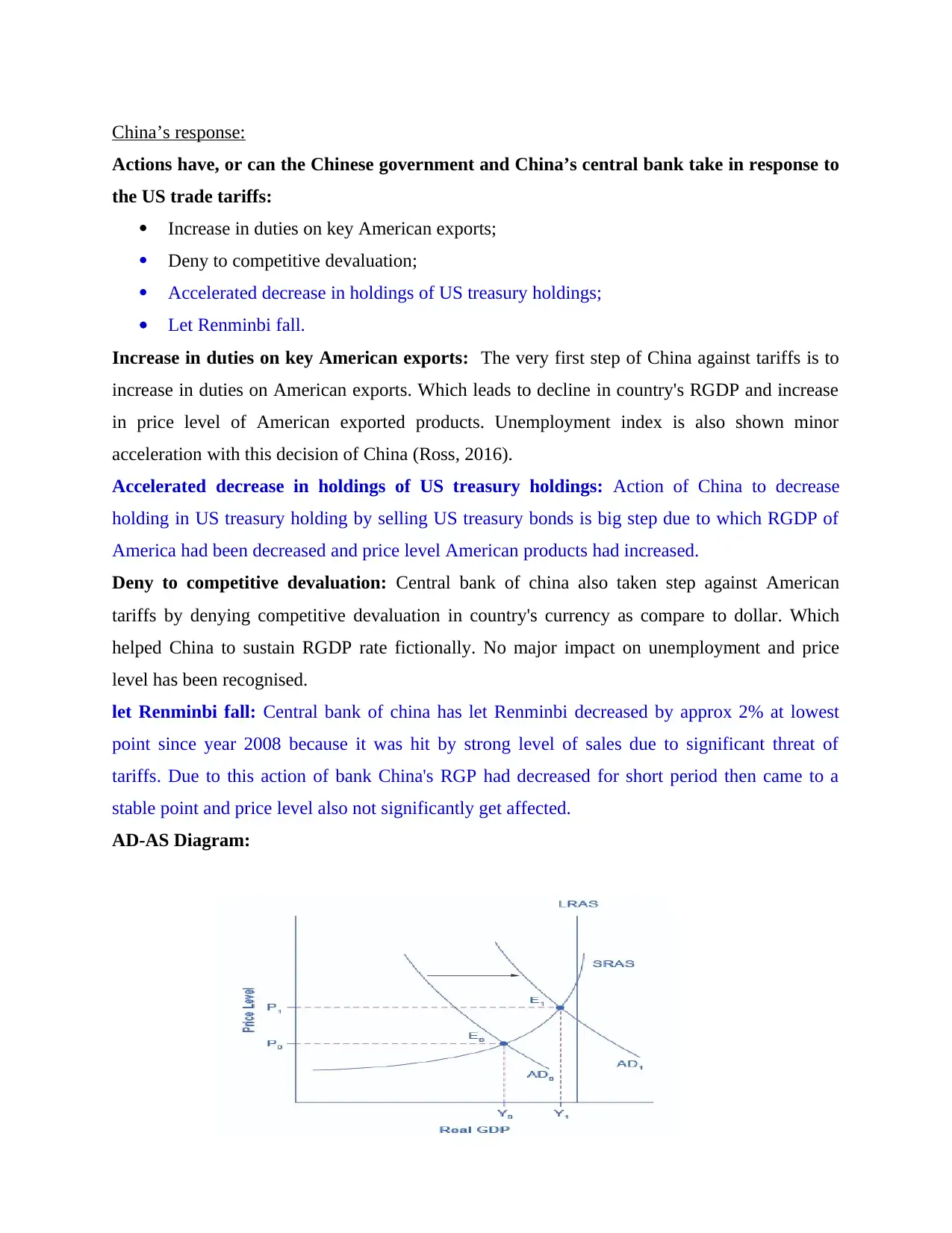
China’s response:
Actions have, or can the Chinese government and China’s central bank take in response to
the US trade tariffs:
Increase in duties on key American exports;
Deny to competitive devaluation;
Accelerated decrease in holdings of US treasury holdings;
Let Renminbi fall.
Increase in duties on key American exports: The very first step of China against tariffs is to
increase in duties on American exports. Which leads to decline in country's RGDP and increase
in price level of American exported products. Unemployment index is also shown minor
acceleration with this decision of China (Ross, 2016).
Accelerated decrease in holdings of US treasury holdings: Action of China to decrease
holding in US treasury holding by selling US treasury bonds is big step due to which RGDP of
America had been decreased and price level American products had increased.
Deny to competitive devaluation: Central bank of china also taken step against American
tariffs by denying competitive devaluation in country's currency as compare to dollar. Which
helped China to sustain RGDP rate fictionally. No major impact on unemployment and price
level has been recognised.
let Renminbi fall: Central bank of china has let Renminbi decreased by approx 2% at lowest
point since year 2008 because it was hit by strong level of sales due to significant threat of
tariffs. Due to this action of bank China's RGP had decreased for short period then came to a
stable point and price level also not significantly get affected.
AD-AS Diagram:
Actions have, or can the Chinese government and China’s central bank take in response to
the US trade tariffs:
Increase in duties on key American exports;
Deny to competitive devaluation;
Accelerated decrease in holdings of US treasury holdings;
Let Renminbi fall.
Increase in duties on key American exports: The very first step of China against tariffs is to
increase in duties on American exports. Which leads to decline in country's RGDP and increase
in price level of American exported products. Unemployment index is also shown minor
acceleration with this decision of China (Ross, 2016).
Accelerated decrease in holdings of US treasury holdings: Action of China to decrease
holding in US treasury holding by selling US treasury bonds is big step due to which RGDP of
America had been decreased and price level American products had increased.
Deny to competitive devaluation: Central bank of china also taken step against American
tariffs by denying competitive devaluation in country's currency as compare to dollar. Which
helped China to sustain RGDP rate fictionally. No major impact on unemployment and price
level has been recognised.
let Renminbi fall: Central bank of china has let Renminbi decreased by approx 2% at lowest
point since year 2008 because it was hit by strong level of sales due to significant threat of
tariffs. Due to this action of bank China's RGP had decreased for short period then came to a
stable point and price level also not significantly get affected.
AD-AS Diagram:
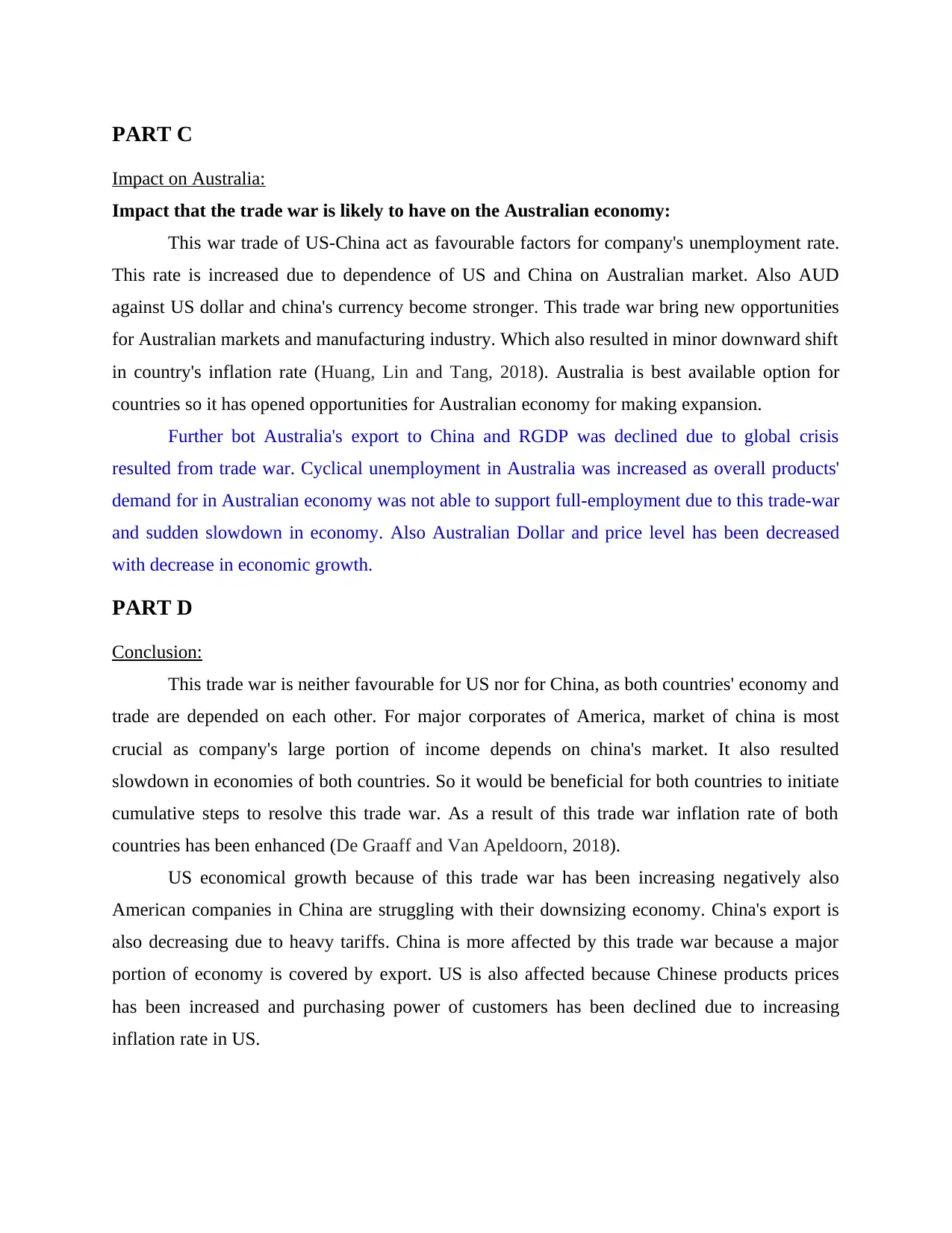
PART C
Impact on Australia:
Impact that the trade war is likely to have on the Australian economy:
This war trade of US-China act as favourable factors for company's unemployment rate.
This rate is increased due to dependence of US and China on Australian market. Also AUD
against US dollar and china's currency become stronger. This trade war bring new opportunities
for Australian markets and manufacturing industry. Which also resulted in minor downward shift
in country's inflation rate (Huang, Lin and Tang, 2018). Australia is best available option for
countries so it has opened opportunities for Australian economy for making expansion.
Further bot Australia's export to China and RGDP was declined due to global crisis
resulted from trade war. Cyclical unemployment in Australia was increased as overall products'
demand for in Australian economy was not able to support full-employment due to this trade-war
and sudden slowdown in economy. Also Australian Dollar and price level has been decreased
with decrease in economic growth.
PART D
Conclusion:
This trade war is neither favourable for US nor for China, as both countries' economy and
trade are depended on each other. For major corporates of America, market of china is most
crucial as company's large portion of income depends on china's market. It also resulted
slowdown in economies of both countries. So it would be beneficial for both countries to initiate
cumulative steps to resolve this trade war. As a result of this trade war inflation rate of both
countries has been enhanced (De Graaff and Van Apeldoorn, 2018).
US economical growth because of this trade war has been increasing negatively also
American companies in China are struggling with their downsizing economy. China's export is
also decreasing due to heavy tariffs. China is more affected by this trade war because a major
portion of economy is covered by export. US is also affected because Chinese products prices
has been increased and purchasing power of customers has been declined due to increasing
inflation rate in US.
Impact on Australia:
Impact that the trade war is likely to have on the Australian economy:
This war trade of US-China act as favourable factors for company's unemployment rate.
This rate is increased due to dependence of US and China on Australian market. Also AUD
against US dollar and china's currency become stronger. This trade war bring new opportunities
for Australian markets and manufacturing industry. Which also resulted in minor downward shift
in country's inflation rate (Huang, Lin and Tang, 2018). Australia is best available option for
countries so it has opened opportunities for Australian economy for making expansion.
Further bot Australia's export to China and RGDP was declined due to global crisis
resulted from trade war. Cyclical unemployment in Australia was increased as overall products'
demand for in Australian economy was not able to support full-employment due to this trade-war
and sudden slowdown in economy. Also Australian Dollar and price level has been decreased
with decrease in economic growth.
PART D
Conclusion:
This trade war is neither favourable for US nor for China, as both countries' economy and
trade are depended on each other. For major corporates of America, market of china is most
crucial as company's large portion of income depends on china's market. It also resulted
slowdown in economies of both countries. So it would be beneficial for both countries to initiate
cumulative steps to resolve this trade war. As a result of this trade war inflation rate of both
countries has been enhanced (De Graaff and Van Apeldoorn, 2018).
US economical growth because of this trade war has been increasing negatively also
American companies in China are struggling with their downsizing economy. China's export is
also decreasing due to heavy tariffs. China is more affected by this trade war because a major
portion of economy is covered by export. US is also affected because Chinese products prices
has been increased and purchasing power of customers has been declined due to increasing
inflation rate in US.
⊘ This is a preview!⊘
Do you want full access?
Subscribe today to unlock all pages.

Trusted by 1+ million students worldwide
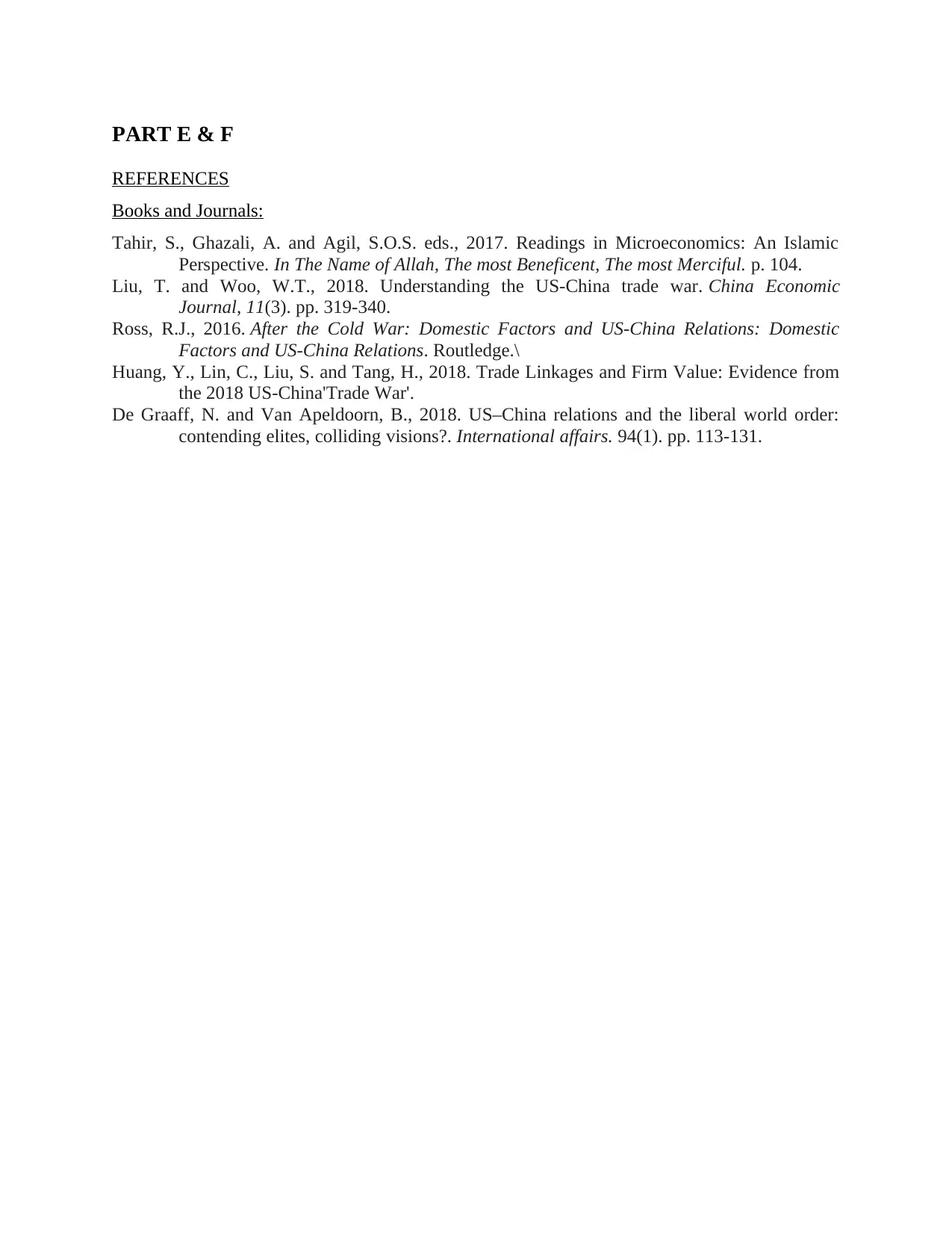
PART E & F
REFERENCES
Books and Journals:
Tahir, S., Ghazali, A. and Agil, S.O.S. eds., 2017. Readings in Microeconomics: An Islamic
Perspective. In The Name of Allah, The most Beneficent, The most Merciful. p. 104.
Liu, T. and Woo, W.T., 2018. Understanding the US-China trade war. China Economic
Journal, 11(3). pp. 319-340.
Ross, R.J., 2016. After the Cold War: Domestic Factors and US-China Relations: Domestic
Factors and US-China Relations. Routledge.\
Huang, Y., Lin, C., Liu, S. and Tang, H., 2018. Trade Linkages and Firm Value: Evidence from
the 2018 US-China'Trade War'.
De Graaff, N. and Van Apeldoorn, B., 2018. US–China relations and the liberal world order:
contending elites, colliding visions?. International affairs. 94(1). pp. 113-131.
REFERENCES
Books and Journals:
Tahir, S., Ghazali, A. and Agil, S.O.S. eds., 2017. Readings in Microeconomics: An Islamic
Perspective. In The Name of Allah, The most Beneficent, The most Merciful. p. 104.
Liu, T. and Woo, W.T., 2018. Understanding the US-China trade war. China Economic
Journal, 11(3). pp. 319-340.
Ross, R.J., 2016. After the Cold War: Domestic Factors and US-China Relations: Domestic
Factors and US-China Relations. Routledge.\
Huang, Y., Lin, C., Liu, S. and Tang, H., 2018. Trade Linkages and Firm Value: Evidence from
the 2018 US-China'Trade War'.
De Graaff, N. and Van Apeldoorn, B., 2018. US–China relations and the liberal world order:
contending elites, colliding visions?. International affairs. 94(1). pp. 113-131.
1 out of 7
Related Documents
Your All-in-One AI-Powered Toolkit for Academic Success.
+13062052269
info@desklib.com
Available 24*7 on WhatsApp / Email
![[object Object]](/_next/static/media/star-bottom.7253800d.svg)
Unlock your academic potential
Copyright © 2020–2025 A2Z Services. All Rights Reserved. Developed and managed by ZUCOL.





